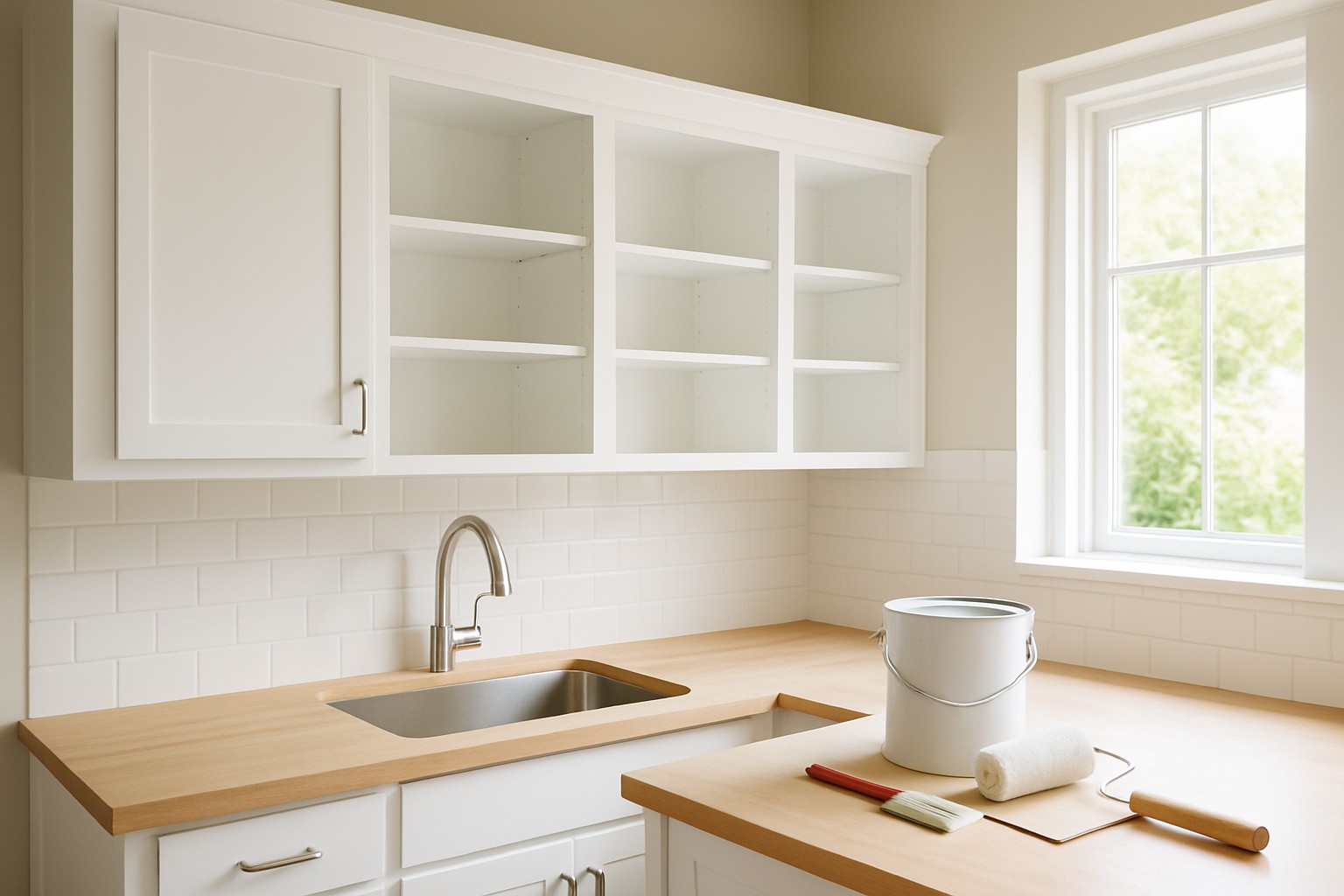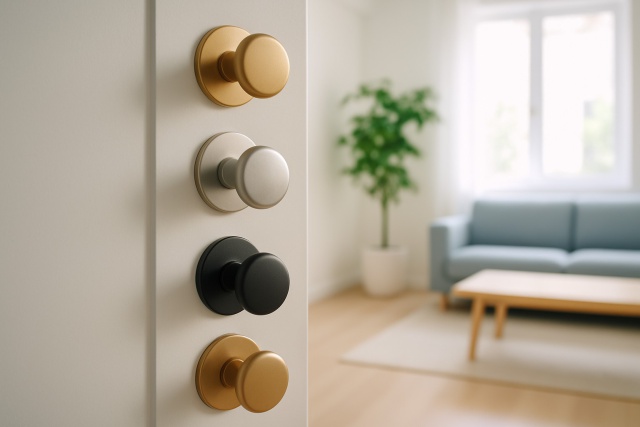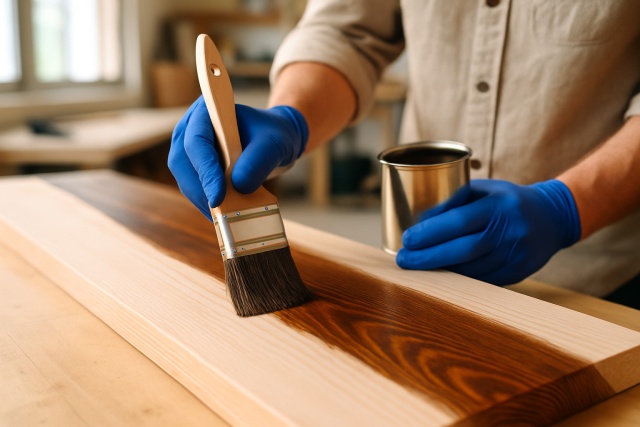Can You Paint the Inside of Kitchen Cabinets Safely?

Wondering can you paint the inside of kitchen cabinets? It's absolutely doable, though it requires solid prep work and choosing the right materials while keeping a keen eye on safety.
Taking a Closer Peek Inside Kitchen Cabinets What They’re Made Of and How They’re Holding Up
Kitchen cabinet interiors come in materials like solid wood, MDF (medium-density fiberboard), laminate, melamine or plywood. Each one has a unique texture and quirks when it comes to taking paint. This affects not just how you paint them but also how long your handiwork lasts.
- Solid wood interiors really show off their natural grain but usually need a good sealing job before painting
- MDF boasts a smooth surface that’s a dream to paint on though it can be sensitive to moisture if you’re not careful
- Laminate and melamine surfaces tend to be slick so they call for special primers to get paint to behave
- Plywood inside cabinets is very sturdy but often has knots and needs careful sanding to look its best
- Many interiors come factory-coated with sealants or finishes which can seriously change how well paint sticks—something to keep in mind
- Cabinets frequently deal with moisture, heat and the occasional greasy splatter inside so they’re no strangers to rough treatment
- Scratches, stains and fading are the usual suspects when it comes to wear and tear inside cabinets
- Keeping a handle on moisture and temperature is key to making sure your paint stays put and looks good for the long haul
Is It Really Safe to Paint the Inside of Kitchen Cabinets? A Few Important Safety Tips You’ll Want to Know
Painting the inside of kitchen cabinets usually goes off without a hitch as long as you keep an eye on a few key things like exposure to VOCs (volatile organic compounds). It’s all about good ventilation, picking non-toxic materials and giving everything ample time to properly cure—patience really pays off here. Safety-wise you’ll want to steer clear of any fire hazards and be extra careful that harsh chemicals or dust don’t sneak onto surfaces where food gets prepped or applied.
- VOCs love to hang around in closed spaces and can really annoy your respiratory system. Using low- or zero-VOC paints is a smart way to keep that risk low.
- Good ventilation is your best friend here. Cranking up fans or opening windows helps air flow while you’re painting and keeps things fresh afterward too.
- Choosing non-toxic, food-safe paints is a no-brainer when it comes to keeping harmful substances out of your kitchen storage areas.
- Dust from sanding and fumes from solvents are not great to breathe, so wearing a mask is a wise choice. It’s better to be safe than sorry.
- Be patient and let the paint fully cure and off-gas before storing any food inside those freshly painted cabinets. Trust me, it makes all the difference.
How to Choose the Best Paint and Primer for Kitchen Cabinets Inside
Picking the right paint for kitchen cabinet interiors is a bit of an art—it’s about striking the perfect balance between durability and safety. You also need to consider smell, finish quality and how well it stands up to moisture or stains. Water-based paints with low VOCs usually take the crown for indoor cabinets. Plus, using a compatible primer isn’t just a good idea; it’s essential because it helps the paint stick like glue and keeps stains or tannins from sneaking through.
| Paint Type | Durability | VOC Levels | Ease of Application | Curing Time | Ideal Use Cases |
|---|---|---|---|---|---|
| Latex | Moderate to High | Low | Pretty straightforward to apply | 24-48 hours | The go-to pick for most cabinet interiors — reliable and fuss-free |
| Acrylic | High | Low to Medium | Fairly straightforward | 24-48 hours | A solid choice when you need water resistance without the drama |
| Oil-based | Very Durable | High | Requires some TLC | 6-8 hours initial; >24 hours full cure | The heavy hitter for cabinets that demand a tough, hard finish |
| Chalk Paint | Moderate | Low | Super easy | 1-2 hours | Great for giving cabinets a quick facelift or that charming decorative touch |
| Shellac | Moderate | Medium | Calls for a careful hand | 45 minutes | The perfect pick to seal knots and keep pesky stains at bay |
Primers do a great job of sealing the cabinet surface and giving paint something to really grab onto. They also keep pesky stains like watermarks or tannin bleed from wood from sneaking through. When you are working with laminate or melamine interiors, reach for bonding primers specially formulated for those slick hard-to-stick surfaces.
Step-by-Step Guide to Safely Painting the Inside of Your Kitchen Cabinets
So, you’re ready to give those cabinet interiors a fresh coat of paint—great choice! Painting inside the cabinets might seem a bit fiddly, but with a little patience and these straightforward steps, you’ll have them looking spick and span in no time. Let’s dive in and make your kitchen feel brand new from the inside out.
Taking a thorough and careful approach really pays off when you want your painted cabinet interiors to come out smooth and built to last. Sticking to proper safety steps at every stage keeps you and your home out of harm's way.
- Take off all the cabinet doors and drawers so you can work on smooth open surfaces without any obstacles.
- Give every inside surface a thorough cleaning with a good degreaser to banish oils and dirt that might sneak past.
- Lightly sand those interiors using fine-grit sandpaper because this step helps the primer grab better.
- Apply the right primer in a well-ventilated space and don’t forget to wear a respirator or mask.
- When it’s time to paint, go for thin even coats to keep drips and bubbles at bay. Slow and steady wins the race here.
- Be patient and let each coat dry and cure fully. Follow the manufacturer’s instructions carefully since rushing this part can come back to haunt you.
- Once the paint is completely cured, carefully pop all your doors, drawers and hardware back in place.
- Finally, give everything a good once-over to catch any spots you missed or stray bits of debris because perfection is in the details.
Key Tips for Ventilating and Staying Safe When Painting Cabinets Indoors
Painting cabinets indoors can be a bit of a double-edged sword it’s super convenient, but you’ve got to be mindful of ventilation and safety. Let’s dive into some practical tips that’ll keep the air fresh and your DIY project hassle-free.
Good ventilation can do wonders for cutting down health risks when painting indoors. Crank up those fans and throw open windows or doors. You can even toss an air purifier into the mix to help sweep away pesky fumes. Don’t forget your personal protective gear—respirators, gloves and eye protection are your best friends for keeping skin irritation and breathing troubles at bay.
- Open windows and doors nearby to create good cross-ventilation while you paint. Fresh air does wonders to keep those fumes at bay
- Use electric fans to bring in fresh air and gently push any stubborn fumes outside where they belong
- Wear N95 or higher-rated masks when sanding or painting indoors because your lungs will thank you later
- Slip on chemical-resistant gloves to keep pesky solvents and paint off your skin since no one wants to wash paint off for hours
- Try to schedule painting sessions when kids and pets are out of the way to minimize their exposure and your worries
Frequent Challenges and How to Tackle Them Like a Pro
Paint peeling and bubbling, stubborn odors that won’t quit, uneven coverage and long drying times can really drive you up the wall when painting inside cabinets. More often than not these headaches stem from sloppy surface prep, moisture issues or simply picking the wrong kind of paint for the job.
- If grease or other contaminants aren’t thoroughly cleaned off the paint often refuses to stick properly and can start peeling sooner than you would like
- High humidity or excess moisture sneaks in and causes bubbling or blistering in the paint layer, making a bit of a mess
- Skipping sanding or primer almost always results in an uneven texture and patchy coverage—something I’ve definitely learned the hard way
- Using high-VOC or oil-based paints in closed spaces tends to crank up odors and raise real health concerns, so ventilation’s your friend here
- Tackling imperfections right away helps stop further damage and keeps that finish looking sharp for a good long while
"You’ve really got to nail the surface prep and pick the right low-VOC materials if you want those kitchen cabinet interiors to not only stay safe but also stand the test of time." — Sarah Jenkins, Finishing Expert
Environmental and Health Considerations When Choosing Alternatives to Traditional Paints What You Really Need to Know
Homeowners who truly care about the environment often choose non-toxic, low-VOC options like water-based paints and natural finishes. These choices do more than just look good. They help reduce health risks and contribute to protecting our planet. They usually hold up well to wear and tear while maintaining excellent indoor air quality and ensuring safety around food storage areas.
- Natural paints crafted from plants or minerals usually help cut down on the flood of chemicals indoors which is always a win for the lungs
- Water-based primers do a great job sealing surfaces and laying down a solid foundation without leaning on heavy-duty solvents that can overpower a room
- Paints tagged zero-VOC often play nice with indoor air quality and tend to keep those pesky paint odors at bay
- Sealants made from plants have a knack for holding moisture back without resorting to harsh chemical tricks
- Just a heads up: some natural finishes might call for a bit more TLC or an extra coat here and there to keep them tough as nails over time
Handy Tips for Keeping Painted Kitchen Cabinet Interiors Looking Sharp
If you're wondering can you paint the inside of kitchen cabinets, the answer is yes - and when well cared for, they can last many years. Just be gentle about cleaning, stick with mild non-abrasive cleaners, and avoid scrubbing hard to keep that lovely paint finish intact.
- Give your cabinets a gentle wipe-down regularly using soft cloths and mild soap because it is the best way to keep pesky scratches at bay
- Avoid abrasive scrubbers and harsh chemicals since they can damage the shiny paint finish you worked hard for
- Try to keep an eye on the kitchen’s humidity levels because too much moisture can cause the paint to bubble or peel which nobody wants
- When you spot small chips or scratches, take a moment to fix them with matching paint right away to prevent them from getting worse
- Every season take a little peek inside your cabinets to catch early signs of wear and tear so they stay looking fresh and top-notch




